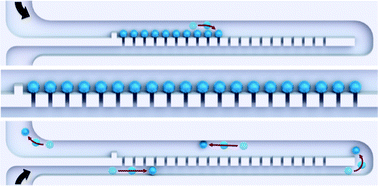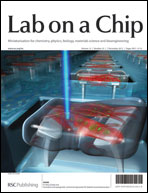Hydrodynamic resettability for a microfluidic particulate-based arraying system†
Abstract
Precision hydrodynamic controls of microparticles (e.g., microbeads and cells) are critical to diverse lab-on-a-chip applications. Microfluidic particulate-based arraying techniques are widely used; however, achieving full microarray resettability without sacrificing trapping performance has remained a significant challenge. Here we present a single-layer hydrodynamic methodology for releasing high numbers of microparticles after a microfluidic arraying process. Experiments with suspended streptavidin-coated polystyrene microbeads (15 μm in diameter) revealed resetting efficiencies of 100%, with trapping and loading efficiencies of 99% and 99.8%, respectively. Experiments with suspended endothelial cells (13–17 μm in diameter) revealed trapping efficiencies of 65% and 93% corresponding to arraying of one cell or at least one cell per trap, respectively, with loading efficiencies of 78%. Full cell-based resettability was also observed, with the caveat that reagents that promote cellular detachment from the substrate were required. The presented resettable microarray could be readily integrated into bead-based or cell-based microfluidic platforms to enable: (i) the retrieval of high numbers of microparticles (e.g., for subsequent analyses and/or use in additional experiments), and (ii) microarray reusability.


 Please wait while we load your content...
Please wait while we load your content...